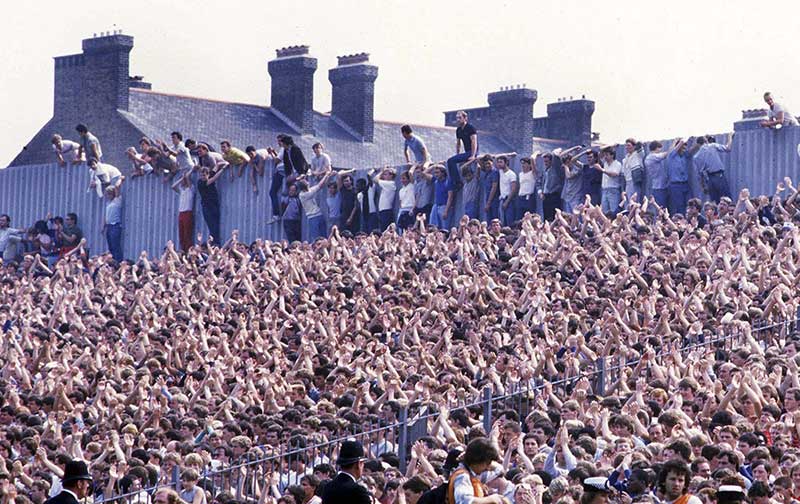
In WSC 294, August 2011, Andrew Woods lamented the decline of the visiting supporters’ section, something that modern clubs just want out of the way
9 November ~ So the North Bank was levelled, the Shed dismantled, the Kippax loaded brick-by-brick into skips. The Shelf and the Kop will meet the wrecking balls soon and attention will shift from the Boleyn Ground to an athletics stadium. For many, the loss of these national treasures is a sad, yet inevitable evolution. If your ground has recently been “Lego-ed” chances are you’ve done your grieving.
Following your team away, however, is losing its magic for me. For a “box-ticker” fuelled by as strong a desire to see the venues as much as my club, travelling is fast becoming a bit of a yawn. Bird-spotters seldom twitch upon discovering a pigeon and so entering the Ricoh, the KC, Madejski, Walkers, St Mary’s, Pride Park and Reebok – tight and compact with noise-nourishing roofs all – one is not exactly compelled to lift the binoculars and wet the pencil. Not least because the away ends of yore, those sections of the ground dedicated solely to the pilgrim, have been one of the major casualties of modern stadium design.
The sweeping bowl, whether a new build or development, with its all-inclusive wave of seats, has all but killed off the football “stand” and, by proxy, the famous and infamous away ends, pens and banks that enriched English football folklore and thus our tales of travel. Just as the beloved home ends are disappearing, so are the integral sections of the ground devoted to the opposition.
An away trip these days seems to be a park and ride to an industrial estate, a drink at a Mexican restaurant before taking your seat tucked away in a corner of the ground (usually named after a photocopier or shoe) next to a half-filled family enclosure. Drain the colour from the circular sweep of plastic and you wouldn’t know where you are; the empty stadium shows no signs of an away section at all.
For many, football grounds are as vital to our perception of our rivals as their kit, badge and star players. As a kid, I could draw from memory, complete with the churches, supermarkets and architectural oddities that in my eyes positively flaunted imperfection, (I knew that China Crisis album title would come in handy one day) most of the grounds I’d seen on the box. Each of the four, or in the case of Oxford’s Manor Ground five, stands were felt-tipped onto A3, and in many cases it was actually the away end that intrigued me more than say the Kop, or the North Bank. After all, when you book a holiday you want to see where you’re staying.
The Clock End open terrace at Highbury with fans sitting atop corrugated fences, the Shakespearean gallery at Goodison’s Park End that overlooked the terrace below and the rat maze at the Milton Road end of The Dell with the “chocolate box” family areas hanging above, each away section offered something unique in hospitality and view. The Dell’s was famously below pitch level at the front. The facilities may have been rudimentary and the “comfort” lacking but that was all part of the experience.
To get to the away end at Cambridge United you took a stroll through a cow field, the visitors’ end at Wigan’s Springfield Park was a mud bank. Filbert Street offered up the entire side stand while Vicarage Road had a detached upended cigar box. Open terraces, tin roofs, supermarket walls, an away trip was partially identified and coded by the mythological presence of these theatres within which the games were played.
Enduring these facilities was a rite of passage, both metaphorically and, in the case of negotiating the Baseball Ground after a shandy, physically. These were sporting venues with faces as distinctive as the haircuts on the pitch and the away sections were, at the very least, the moustache. Visiting grounds these days – and I’m sure it’s the same for people visiting my club – can be about as breathtaking as visiting Gap in a foreign city.
Watching games on TV these days, it seems more and more as though the away end is actually disappeared altogether. You will often see visiting players celebrating goals in front of arms-crossed grumpy home fans, unaware of where their own support actually is. Indeed, many of the developed and new grounds have tried their best to lift the rug when it comes to housing their guests. Hidden away in a quiche-slice triangle inserted into the corner or “bend” of the ground, or tucked away on a top shelf – yes Newcastle – like a seldom-used bag of self-raising.
Everton, Villa, Manchester United, Coventry, Ipswich, Norwich, Cardiff – and many more – are all clubs who have shifted the away fans into more passive (not visible on TV) areas of the ground. At more sparsely populated grounds, like the Kassam, this spells complete gloom as away supporters are plonked straight into the middle of uninhabited wastelands, where even the introduction of fire-breathing elephants would fail to charge the atmosphere.
Fans of a certain age will remember the fanzine thinkpieces and letters ranting at the archaic dumps we had to visit and the piss-poor away ends. The crummy Dell was a stick with which to beat the Saints. An embarrassment. Yet check the message boards now and there’s a palpable sense of loss, and an acknowledgement that getting a new stadium is not only now perceived as regressive, but also the end. Once you have an identikit stadium, that’s it, squire. But what great facilities, eh? Andrew Woods
This article first appeared in WSC 294, August 2011. Subscribers get free access to the complete WSC digital archive – you can find out more details here
Photo via Colorsport: Highbury’s Clock End packed out in 1984 for a match between Arsenal and Chelsea